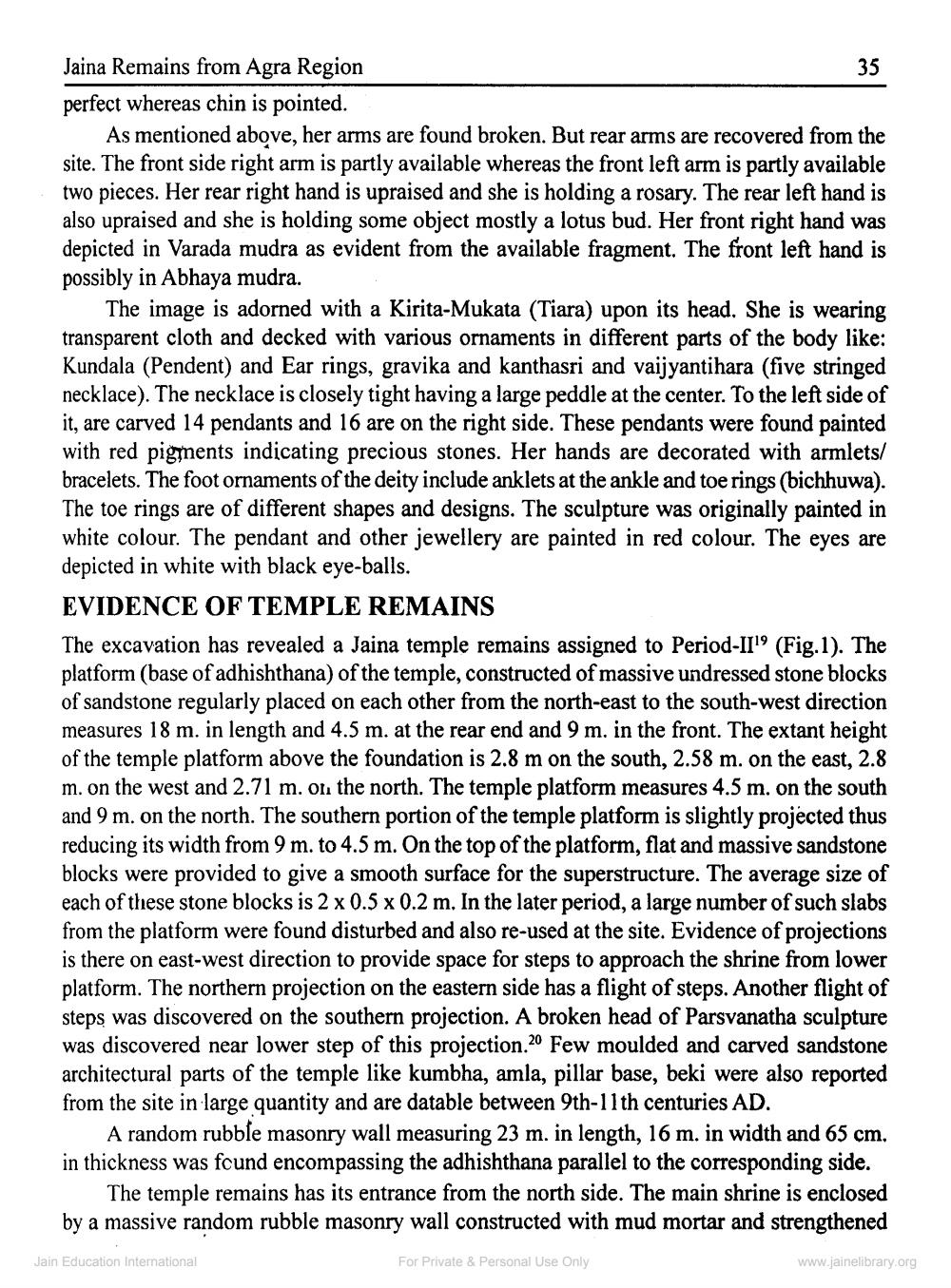________________
35
Jaina Remains from Agra Region perfect whereas chin is pointed.
As mentioned above, her arms are found broken. But rear arms are recovered from the site. The front side right arm is partly available whereas the front left arm is partly available two pieces. Her rear right hand is upraised and she is holding a rosary. The rear left hand is
raised and she is holding some object mostly a lotus bud. Her front right hand was depicted in Varada mudra as evident from the available fragment. The front left hand is possibly in Abhaya mudra.
The image is adorned with a Kirita-Mukata (Tiara) upon its head. She is wearing transparent cloth and decked with various ornaments in different parts of the body like: Kundala (Pendent) and Ear rings, gravika and kanthasri and vaijyantihara (five stringed necklace). The necklace is closely tight having a large peddle at the center. To the left side of it, are carved 14 pendants and 16 are on the right side. These pendants were found painted with red pigments indicating precious stones. Her hands are decorated with armlets/ bracelets. The foot ornaments of the deity include anklets at the ankle and toe rings (bichhuwa). The toe rings are of different shapes and designs. The sculpture was originally painted in white colour. The pendant and other jewellery are painted in red colour. The eyes are depicted in white with black eye-balls. EVIDENCE OF TEMPLE REMAINS The excavation has revealed a Jaina temple remains assigned to Period-II" (Fig.1). The platform (base of adhishthana) of the temple, constructed of massive undressed stone blocks of sandstone regularly placed on each other from the north-east to the south-west direction measures 18 m. in length and 4.5 m. at the rear end and 9 m. in the front. The extant height of the temple platform above the foundation is 2.8 m on the south, 2.58 m. on the east, 2.8 m. on the west and 2.71 m. on the north. The temple platform measures 4.5 m. on the south and 9 m. on the north. The southern portion of the temple platform is slightly projected thus reducing its width from 9 m. to 4.5 m. On the top of the platform, flat and massive sandstone blocks were provided to give a smooth surface for the superstructure. The average size of each of these stone blocks is 2 x 0.5 x 0.2 m. In the later period, a large number of such slabs from the platform were found disturbed and also re-used at the site. Evidence of projections is there on east-west direction to provide space for steps to approach the shrine from lower platform. The northern projection on the eastern side has a flight of steps. Another flight of steps was discovered on the southern projection. A broken head of Parsvanatha sculpture was discovered near lower step of this projection.20 Few moulded and carved sandstone architectural parts of the temple like kumbha, amla, pillar base, beki were also reported from the site in large quantity and are datable between 9th-11th centuries AD.
A random rubble masonry wall measuring 23 m. in length, 16 m. in width and 65 cm. in thickness was found encompassing the adhishthana parallel to the corresponding side.
The temple remains has its entrance from the north side. The main shrine is enclosed by a massive random rubble masonry wall constructed with mud mortar and strengthened
Jain Education International
For Private & Personal Use Only
www.jainelibrary.org




